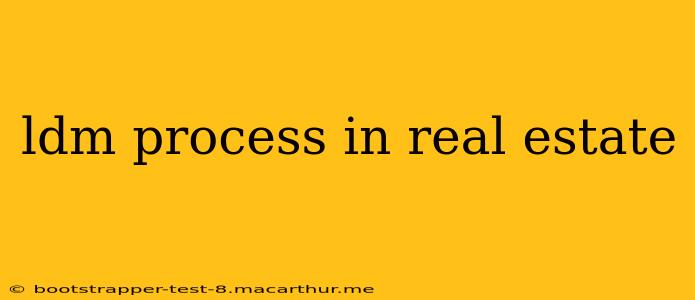The Linear Direct Marketing (LDM) process, while not explicitly named as such in the real estate industry, represents a core strategy for many successful agents and companies. It focuses on a targeted, sequential approach to lead generation and conversion, leveraging direct communication channels to nurture prospects into clients. This guide will break down the LDM process in real estate, examining its key components and how they contribute to a successful sales funnel.
What is the LDM Process in Real Estate?
In essence, the LDM process in real estate involves a structured, linear path of communication designed to move leads through distinct stages, from initial contact to closing a deal. Unlike more broad-based marketing, LDM emphasizes personalization and direct engagement. Each stage builds upon the previous one, cultivating a relationship and ultimately converting the lead into a paying client. This might involve a series of targeted emails, phone calls, direct mail pieces, or even in-person meetings, all carefully sequenced and tailored to the individual prospect.
Key Stages of the LDM Process in Real Estate
The exact steps in an LDM process can vary, but most successful strategies include these core elements:
1. Lead Generation and Qualification:
This initial phase focuses on attracting potential clients. Sources can include:
- Online advertising: Targeted ads on social media and search engines.
- Open houses: Generating leads directly through in-person interaction.
- Networking events: Building relationships with potential referrals.
- Website forms: Capturing contact details through online inquiries.
Qualifying leads is crucial; this involves assessing their seriousness, budget, timeline, and needs. Filtering out unqualified leads saves time and resources.
2. Initial Contact and Engagement:
Once a lead is qualified, the next step involves making that initial contact. This is often a personalized email, phone call, or text message, introducing yourself and expressing genuine interest in their needs. The goal is to establish rapport and begin building a relationship.
3. Information Gathering and Needs Analysis:
This stage is all about understanding the lead's specific requirements. This might involve asking targeted questions about their desired property type, location preferences, budget constraints, and timeline. Active listening is key.
4. Property Presentation and Value Proposition:
Based on the information gathered, you can now present relevant properties or present your value proposition (i.e. what makes you the best agent to help them achieve their goals). This might involve virtual tours, detailed property descriptions, market analysis, or comparative market analyses (CMAs).
5. Building Trust and Rapport:
Trust is paramount in real estate. This stage focuses on building a strong, trusting relationship with the lead through open communication, responsiveness, and consistent follow-up. This goes beyond just transactional communication; building a genuine rapport increases your chances of conversion.
6. Offer Negotiation and Closing:
Once the lead is ready to make an offer, you guide them through the negotiation process, ensuring a fair and satisfactory outcome for both parties. This involves navigating potential challenges, handling objections, and providing expert advice. The final stage is closing the deal, completing all the necessary paperwork, and ensuring a smooth transition for the client.
How to Optimize your LDM Process in Real Estate
Effective LDM requires ongoing refinement and optimization. Here are some key strategies:
- Track your results: Use analytics to monitor which stages are most effective and which need improvement.
- Personalize your communication: Tailor your messaging to each individual lead's needs and preferences.
- Automate where possible: Use CRM software and marketing automation tools to streamline the process.
- Continuously improve your lead generation strategies: Always be looking for new and innovative ways to attract potential clients.
- Provide exceptional customer service: Positive client experiences lead to referrals and repeat business.
Frequently Asked Questions
What tools can help with the LDM process in real estate?
Several CRM (Customer Relationship Management) systems and marketing automation tools can assist with streamlining the LDM process, offering features for contact management, lead nurturing, email marketing, and more. Researching options tailored to real estate is recommended.
Is the LDM process suitable for all real estate agents?
While the LDM process offers a structured approach beneficial to many, its effectiveness depends on factors like the agent's personality, target market, and available resources. Those who thrive on personalized communication and strategic planning often find LDM particularly effective.
What are the key metrics to track for an LDM process?
Key metrics include lead conversion rates at each stage, the time taken to convert leads, customer acquisition costs, and the overall return on investment (ROI) of the LDM strategy. Regular monitoring allows for timely adjustments to optimize the process.
By implementing a well-defined LDM process and continuously optimizing it based on performance data, real estate professionals can significantly improve their lead conversion rates and build a more sustainable and successful business. Remember that building trust and providing exceptional service are key differentiators in a competitive market.
